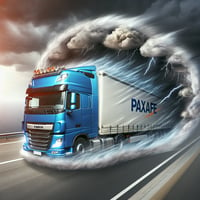Why Agentic Workflows Won’t Save Your Control Tower Without the Proper Infrastructure

You’ve finally got your Tesla with Full Self-Driving.
It rolls up to you from a few hundred feet away in the dealership lot. Impressive.
Now imagine taking delivery in the middle of the desert: no roads, no traffic data, no GPS connectivity, no charging stations.
The car looks futuristic. The feature demo is slick. But let’s be honest — it’s useless. You wouldn’t trust it to get you home.
That’s exactly what happens when you bolt “agentic workflows” onto a pharma control tower without the proper infrastructure. You get automation with nowhere to go — flashy, fragile, and not trusted when it matters.
🚗 Self-Driving Cars Need Foundations
The first public vision of self-driving cars wasn’t Tesla — it was GM’s Futurama exhibit at the 1939 World’s Fair. They promised cars that could drive themselves down automated highways. Futuristic? Absolutely. Realistic? Not even close. The foundations — roads, sensors, maps, and traffic rules — took decades to build before autonomy was even possible.
Cold chain has followed the same arc. We crawled from data loggers and carrier milestones to IoT sensors … but for years still lacked the real infrastructure: aggregated, data-agnostic feeds & APIs, digitized SOPs, external impacts like weather and dwell, and the intelligence to power the entire value chain – from planning, to operations, to quality resolution, and to aggregate insights that feed back into your planning cycle.
And just like self-driving cars, cold chain “autonomy” collapses without the foundations. You wouldn’t trust a car to steer itself with no roads, no sensors, and no traffic rules. And you shouldn’t trust “agentic workflows” without digitized SOPs, contextual data, and GxP validation.
🛠️ The Four Automations That Actually Matter
Because PAXAFE built the highways first — data-agnostic feeds, digitized SOPs, contextual risk, and GxP validation — we can now deliver the four automations that pharma actually cares about. Think of them as the trusted “self-driving features” for your control tower:

- Automated Exceptions Monitoring → Tesla Autopilot drift & object detection
Without Autopilot features like lane drift detection or car-ahead warnings, you’d be white-knuckling the wheel every second. That’s how most control towers run today: manual, reactive, exhausting.
- What others pitch: “Our agents will monitor alerts automatically.”
- The gap: Without stability budgets, packaging details and context, they swerve at every bump and slam the brakes at every false alarm.
- PAXAFE: ATHENA filters the noise, flags & contextualizes only true risk, and slashes hyper-care costs. Real autopilot, trusted at scale.

- Automated Temperature Release → Automatic Braking & Crash Tests
Tesla’s emergency braking only works because the system has been validated through millions of miles and safety trials. Would you trust it without that? Exactly.
- What others pitch: “Agents can accelerate release decisions.”
- The gap: Without GxP validation, audit trails and a robust rules configuration engine, every release becomes a compliance gamble.
- PAXAFE: Device-agnostic ingestion + digitized stability profiles + configurable workflows make release decisions same-day; not 7–10 days in queue, 30 emails + PDF & CSV attachments. Safe, compliant, and auditable.

- Automated Lane Performance & Risk Insights → Live Maps & Rerouting
Tesla doesn’t just know where you are — it knows where traffic is building and reroutes in real time. Control towers need the same intelligence.
- What others pitch: “Agents can optimize lanes dynamically.”
- The gap: If lane qualifications live in PDFs, an agent can’t tell if a lane is compliant or safe, or how to best optimize decisions in accordance with existing processes / workflows.
- PAXAFE: Lane Manager digitizes SOPs and continuously scores performance against real-world data, prescribing better vendor, route, and packaging choices.

- Automated Recommendations → Navigate on Autopilot
Tesla’s Navigate on Autopilot handles merges, exits, and lane changes seamlessly. It doesn’t just steer — it guides.
- What others pitch: “Agents will tell you what to do.”
- The gap: Without integrated, contextual data, recs are just guesswork dressed up as AI. Recommendations that fail to consider SOPs and various data sources (e.g. passive loggers, IoT, carrier milestones, trailer data, shipment documentation data, quality data, etc.) will generate recommendations that are not actionable, not possible, or too expensive to implement.
- PAXAFE: ATHENA’s closed-loop flywheel (Plan ↔ Execute ↔ Refine) delivers prescriptive actions grounded in validated data. Recommendations you can trust, not hope.

🚨 The Punchline
Buying agentic workflows without infrastructure is like buying a Tesla with Full Self-Driving and dropping it in the middle of the desert. The demo looks slick, but there are no roads, no maps, no safety validation, no trust.
Pharma can’t afford faster wrong answers. Regulators won’t accept black-box decisions. QA won’t sign off on hallucinations.
That’s why PAXAFE built the highways first: digitized SOPs, contextual risk intelligence, and GxP-validated workflows. Our automations aren’t “beta features.” They’re trusted, compliant, and saving pharma money today.
Agentic AI won’t save your control tower.
Infrastructure will.




